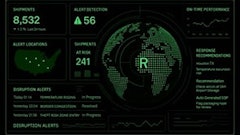
As retailers finalize their peak season preparation, they continue to face a barrage of complex challenges, including fallout from ongoing tariff conversations, persistent economic volatility, and labor shortages. But the most formidable challenge isn’t any one of these factors, it is the uncertainty they collectively create.
Today’s retailers now need to navigate a rapidly changing landscape where old strategies and legacy technologies will limit their ability to respond to new challenges. Instead, leaders need to upgrade their supply chain execution strategies to prepare for the unpredictable and remain agile in the face of continuous change.
It is nearly impossible to pinpoint where and when exact disruptions will impact the supply chain, but companies can still prepare by prioritizing visibility, which is actionable, leveraging predictive analytics, and implementing new technologies in a modular fashion with rapid ROI.
What retailers can expect this peak season
While it is nearly impossible to anticipate all the peak season planning roadblocks, especially months in advance, there are a few persistent challenges retailers should prepare to address ahead of this year’s busy season.
1. Persistent tariff pressures. As ongoing tariff conversations and negotiations continue, it is difficult to predict the longer-term impacts that will result. However, potential supply chain impacts span across operations, including manufacturing, sourcing, shipping, and more.
2. Shifting consumer demands. Economic volatility is showing no signs of slowing down, which could lead to more cautious spending heading into peak season. This will not only impact how much money consumers are willing to spend, but also when and where they plan to shop this year.
3. Labor shortages. Despite the economic volatility, finding and retaining seasonal employees continues to be a challenge for companies.
With each of these challenges comes a unique form of uncertainty. Will tariffs make it too difficult and costly to source inventory ahead of peak season? Will the slowdown in consumer spending leave the company with overflowing inventory? Will ongoing labor challenges make it difficult to fully staff fulfillment centers?
To manage this uncertainty, retailers must evaluate and update their supply chain strategies to ensure they are optimizing operations and avoiding unnecessary costs.
Managing uncertainty through visibility
Preparing for the unexpected has become a norm in the supply chain space, with new challenges continuing to surface regularly. In this environment, traditional long-term planning isn’t necessarily enough. Retailers now need to consider a more adaptive approach to supply chain execution that relies on flexibility.
This needed approach starts with visibility. To fully understand planning needs, supply chain leaders must first ensure they have a clear vision into their end-to-end supply chain execution process. This includes sourcing, inventory, shipment tracking, labor availability, and more. End-to-end visibility into these processes will enable faster decision making, minimize the impact of disruptions, and allow teams to take a more active approach to managing uncertainty.
AI can be a powerful tool in automating and streamlining this process, offering analytics and reporting capabilities so retailers can quickly process their supply chain data and make more informed decisions. For example, AI solutions can be utilized to analyze current and past inventory data, while tracking against historic numbers and ongoing trends, to make predictions for leaders to use as baselines for planning. Then these baselines can be used to make precise customer promises while dealing with inventory uncertainty, which significantly increases during retailers’ peaks.
In addition to inventory disruptions, AI solutions also present opportunities to address challenges around economic volatility and labor shortages. With visibility into how products are moving, costs, and port disruptions, AI solutions will give leaders the ability to optimize their operations and explore new ways to save costs by feeding machine learning predictions into execution systems. As such, AI presents an automated solution for a process that was once manual and labor intensive – usually done with explicit rules configuration and manual adjustments.
GenAI’s potential for managing peak season execution
GenAI is a powerful tool from a planning perspective. Yet, there is untapped potential for utilizing GenAI from an execution standpoint to help better address and prepare for ongoing disruptions.
Though these capabilities have yet to take hold, the future of AI agents in the supply chain space is promising for future peak seasons. For example, AI agents have the capabilities to be a great tool for carrier communications, automatically calling carriers for updates on shipment statuses and updating customers in real time.
While this is just one potential use case, as agentic AI solutions continue to evolve, it will be a trend to watch for peak seasons to come, especially as the rate of supply chain disruptions continues to intensify. Imagine a world where autonomous agents can react to various disruptions in order fulfillment or warehouse slowdown. If the order fulfillment rate is falling at one location, an agent can proactively reroute additional orders to another warehouse for fulfillment, while dynamically updating unanticipated transport loads and reprioritizing work in the warehouse.
Turning uncertainty into an advantage
While uncertainty can be tough to navigate, especially around peak season planning and execution, it provides companies with a great opportunity to build long-term supply chain resilience. By enhancing supply chain strategies to become more flexible, companies will better position themselves to manage their supply chain throughout the holiday shopping peak and beyond.

















